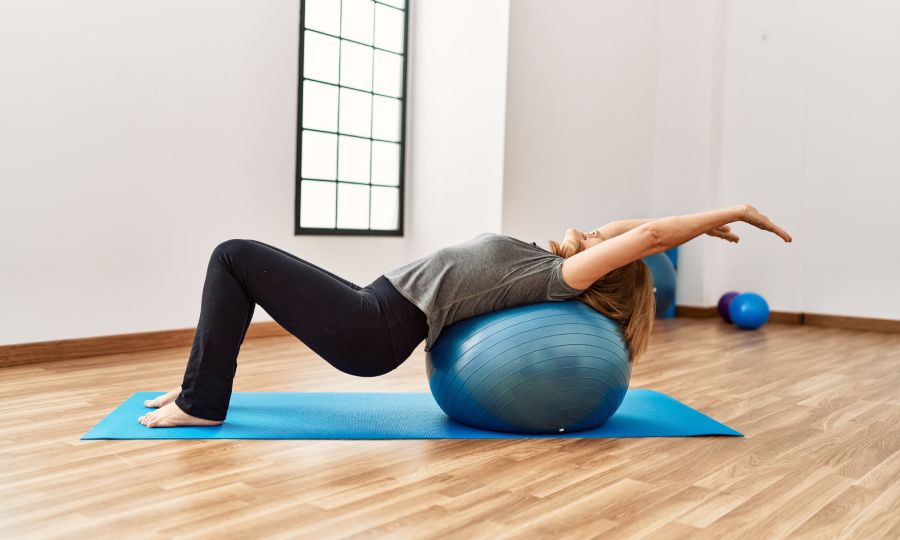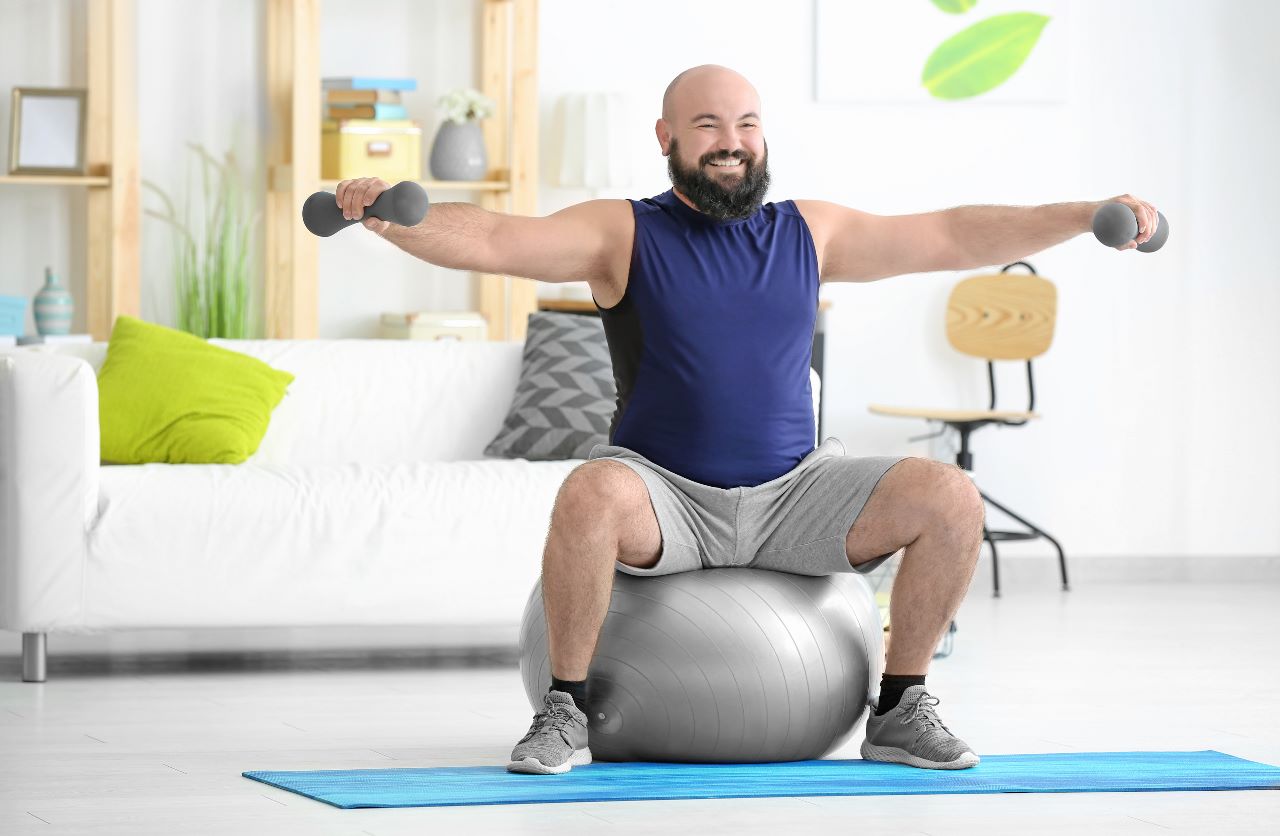By Angelica Bottaro
Medically reviewed by Yasmine S. Ali, MD, MSCI
Researchers are not exactly sure how obesity affects bone density, but recent studies have suggested that obesity and osteoporosis might be connected.
Nearly 30% of people with osteoporosis are overweight or have obesity. People with obesity who also have osteoporosis might be more prone to fractures from low-impact movements.1
EXERCISES FOR OVERWEIGHT/OBESE PEOPLE. SET NO. 3: POWER EXERCISES WITH DUMBBELLS. WEIGHT IS SELECTED INDIVIDUALLY. IT IS RECOMMENDED TO START WITH 1-2 KG
While the findings from studies on obesity and osteoporosis have been inconsistent, researchers are looking at a possible link between the two that could lead to obesity becoming another factor that drives the onset of this type of bone disease.
Obesity and Bone Health
The long-held notion that carrying more weight means that a person has stronger bones is slowly being disproven. Recent reviews on the literature exploring obesity and bone health have found that several factors are at play when someone is carrying extra weight and what that means for their ability to maintain proper bone health.

A person’s body weight, fat volume, the formation and breakdown of bones, fat in bone marrow, and inflammation caused by immune cells (pro-inflammatory cytokines) are factors that need to be taken into account to address the connection between bone health and obesity.2
Types of Fat
There are three types of fat: brown, white, and beige.
- Brown fat, or “good fat,” helps the body with temperature regulation.
- White fat accumulates in the body and can contribute to health conditions.
- Beige fat cells come from white fat and are typically found near the spine and collarbone.
Beige and brown fat can burn fat, while white fat stores it.
One research paper examined the effects that molecules produced by body fat (adipokines) have on bone cells. The paper also looked at the relationship between the continuous cycle of bone growth and breakdown (bone metabolism), white fat in bone marrow, and brown fat (the type of fat that converts food into body heat).
The findings showed a connection between obesity and bone metabolism; however, it’s not yet entirely clear what it is. What is known is that fat tissue interacts with bones by releasing certain cytokines in an attempt to regulate the health of the bones.
Bone marrow fat tissue also plays an important role in bone density and structure. The paper further found that because obesity is often correlated with nutrition imbalances (such as a lack of vitamin D, calcium, or phosphorous), it is hard to determine exactly why obesity impacts bone health.2
Misconceptions
It has been a widely accepted notion that only frail, older adults develop osteoporosis; however, many factors contribute to the risk and onset of the disease.
Older adults (especially women) are at a high risk of osteoporosis, but recent research on obesity and osteoporosis has found that being frail is not necessarily a prerequisite for this type of bone disease.
Childhood Obesity
Decades of research on the connection between bone health and childhood obesity have found that it is a complex relationship.

Roughly 25% of a person’s bone mass is accrued during childhood. Studies have shown that because of how obesity affects bone mass as children grow, childhood obesity could increase both their risk for fractures as they get older as well as the development of osteoporosis.3
Bone mass is thought to be reduced in children with obesity—a fact that’s contradictory to the previously held notion that larger children had higher bone mineral density.
It has also been found that if a child has a lower bone mass as they are growing, they will also have lower bone mass into adulthood, which could put them at a higher risk for osteoporosis in the future.3
How Common Is Childhood Obesity?
According to the Centers for Disease Control and Prevention, roughly 14.4 million American children and adolescents have obesity—roughly 19.3% of the age group’s population in the United States.4
Video: “EXERCISES FOR OVERWEIGHT | OBESE PEOPLE”
EXERCISES FOR OVERWEIGHT | OBESE PEOPLE. SET NO. 1: GENERAL EXERCISES TO STRENGTHEN MUSCLES AND IMPROVE JOINT MOBILITY
For additional information about Rehabilitation of the patients with Obesity you can watch a video demonstrating exercises and rehabilitation recommendations.
Obesity Causes
The most basic cause of obesity is taking in more calories than your body needs—be it by eating more than your body needs for energy or not participating in enough physical activity to burn the excess calories.5

However, many factors can contribute to the development of obesity, including:6
- Smoking or using other substances
- Age
- Certain medical conditions or medications (e.g., polycystic ovary syndrome, antidepressants)
- Genetic response to changes in a person’s environment
- Food marketing and promotion where a person lives
- Lack of education on proper nutrition
- Lack of skills for preparing nutritious meals
- Community factors (e.g., lack of sidewalks or safe bike trails that may prevent safe walking)
- Societal factors or limitations (e.g., lack of supportive information on health-promoting habits and practices)
Osteoporosis Causes
The causes of osteoporosis and obesity share some similarities. Smoking, lack of sufficient weight-bearing exercise, aging, diet, as well as certain medical conditions and medications can increase the risk for both osteoporosis and obesity.
There are also a few other known risk factors for osteoporosis:
- Low levels of estrogen
- Lack of vitamin D and calcium in the diet
- Sedentary lifestyle
Obesity and Osteoporosis Treatment
Weight loss can be difficult, especially if a person has factors that affect their weight (like certain medical conditions or medications) or they have not been given the tools and support that they need.
Still, losing weight is often an important component, not just of managing or treating certain health conditions, but preventing them as well.
Lifestyle Changes
Safe and effective weight loss can be achieved by making a commitment to lifestyle changes that support a healthier weight.

Often, these changes are small but still have an impact. Some lifestyle modifications that you can make as you work on losing weight include:
- Set small, realistic goals: If you have over 100 pounds to lose, making a plan might feel daunting or even impossible. However, making small goals for yourself (such as losing 10 pounds at a time) can help you stay motivated throughout the process.
- Choose a nutritious diet: Research shows that there is no one diet that is superior for weight loss. You have to pick the right diet for you. Options include low-calorie, low-carb, low-fat, high-fat, high-protein, or Mediterranean diets, or intermittent fasting. Generally, the best diet is the one you will stick to.7
- Exercise more: Any exercise is better than no exercise at all. Research has shown that the best exercise for weight loss burns a lot of calories and is easy to stick with long term (which will be easier if you pick something you like doing). Examples of exercises that you might want to try include endurance training, high-intensity interval training, and weight or resistance training.
Safe Exercises
If you have obesity, osteoporosis, or both, getting regular physical activity can be beneficial, but there are some steps you will want to take to make sure that you are exercising safely with these conditions.
Exercising With Osteoporosis
Exercising when you have osteoporosis will help maintain your bone health, as well as your muscle mass. However, if you have weaker bones, there are some risks associated with certain types of exercise that can lead to a fracture.

According to the National Osteoporosis Foundation, the following exercises are safe to do if you have osteoporosis:8
- Posture exercises can help improve your posture and decrease the risk of breaking a bone in your spine.
- Strengthening exercises help strengthen the muscles around your bones.
- Balance exercises can help prevent falls.
- Functional exercises address problems you have in everyday life, such as not being able to walk up stairs.
If you find it hard to climb stairs, the National Osteoporosis Foundation suggests that you slowly introduce stairs as a basic exercise to help increase your ability.
Exercising With Obesity
People with obesity must take some precautions when they are exercising. For example, start with low-impact exercises, such as walking or swimming, to limit the stress on your body and joints.

You should ease into exercise slowly and build up to more strenuous activity over time. Examples of exercises you might want to try include:
- Water aerobics
- Stationary cycling
Talk to Your Doctor
Always speak to your doctor before starting a new exercise routine. They can help determine which exercises will be safe and the most beneficial for you.
Video: “HYDROTHERAPY MODULE. EXERCISES FOR OVERWEIGHT | OBESE PEOPLE”
EXERCISES FOR OVERWEIGHT/OBESE PEOPLE. HYDROTHERAPY MODULE: SWIMMING AND HYDROTHERAPY, EXERCISES IN THE WATER
For additional information about Hydrotherapy for the patients with Obesity you can watch a video demonstrating exercises and rehabilitation recommendations.
Medication
Prescription medication for weight loss works in different ways. Some medications may cause you to feel full sooner, which leads you to eat fewer calories. Others hinder your body from absorbing the fat from the foods that you eat.

Typically, a prescription medication for weight loss is prescribed to people who have health issues related to obesity. While many people may think that taking medication to lose weight will eliminate the need for exercise and healthy eating, that is not true. The medications need to be taken to help a person live a healthier lifestyle.9
Some prescription medications available to help with weight loss include:9
- Orlistat: Works to reduce the amount of fat absorbed from the food you eat
- Phentermine-topiramate: A combination drug that lessens appetite
- Naltrexone-bupropion: A combination drug that helps to make you feel fuller faster
- Liraglutide: Regulates appetite
- Semaglutide: Regulates appetite
- Setmelanotide: Reduces appetite and increases metabolism
Surgery
In some cases, people who need to lose weight will benefit from having surgery to help them meet their goals. However, a person must fall into the category of extreme obesity on the body mass index (BMI) scale to be considered for these procedures.10

There are three main types of weight loss surgery:10
- Adjustable gastric banding: During this surgery, a band filled with saltwater is placed around the upper part of the stomach. It is designed to make the stomach smaller, which helps a person consume less food.
- Gastric sleeve: During this procedure, more than half of the stomach is removed. A sleeve or tube the size of a banana is left in the area. Similar to band surgery, this procedure shrinks the stomach to allow less food to be consumed.
- Gastric bypass: During gastric bypass surgery, the surgeon creates a smaller stomach by taking part of a person’s existing stomach and attaching it to the middle part of the small intestine. When a person eats, the food bypasses the rest of the stomach, which limits the amount of food the body digests and processes. This, in turn, reduces the calories that are absorbed.
Weight loss surgeries can be done with a large cut made in the abdomen (open) or with tools to enter the abdomen through several small cuts (laparoscopically). Laparoscopic surgery also uses cameras to help the surgeon see inside the abdomen.
Natural Treatments
Not many natural remedies are scientifically proven to help reduce weight, but a few have been investigated, including:

- Green tea: Drinking green tea (without any added sugar or milk) can help to increase the energy that your body expends and may help burn belly fat when combined with a nutritious diet and exercise regimen.11
- Probiotics: Probiotics are “good” bacteria that can help improve digestive health. Research has shown that taking probiotics can help the body block the absorption of fat from the foods you eat and may help reduce your appetite.12
- Mindfulness: Mindful eating is a practice where you work on being aware and present while you eat. Studies have shown that mindfulness at mealtimes can help decrease stress eating, as well as help people make more nutritious food choices and become more aware of their hunger cues.13
Do Natural Remedies Really Work?
There is some clinical evidence to back up the claims that natural remedies can lead to weight loss, but they should be treated as an addition to a healthier lifestyle rather than a “cure-all” solution.
Modest weight loss may occur if you add in these natural remedies, but for long-term and lasting weight loss, you will need to implement more changes to your lifestyle and habits.
By Angelica Bottaro
Angelica Bottaro is a professional freelance writer with over 5 years of experience. She has been educated in both psychology and journalism, and her dual education has given her the research and writing skills needed to deliver sound and engaging content in the health space.
Summary
Many factors contribute to the development of osteoporosis, and to some extent, bone loss is a normal part of the aging process. However, research has shown that people with obesity tend to age faster (in fact, obesity may accelerate aging by over two years).
Combined with the recent research that suggests that obesity affects bone health, having obesity could also contribute to your risk of developing osteoporosis.
Conclusion
There are ways to reduce your risk of obesity and osteoporosis, including eating a nutritious diet and getting more physically active. Talk to your doctor about the support you need to lose and maintain a weight that is most healthy for you.
FREQUENTLY ASKED QUESTIONS
-
Does being obese change bone density?
Recent research has shown that obesity does have an effect on bone density. In particular, people with obesity have a lower bone density in relation to their body weight, as well as an increased risk of fractures.
-
Can overweight children develop osteopenia?
Having excess body weight as a child can affect the development of bone, which can lead to an increase in bone frailty as a person ages.14 While there is limited research on childhood obesity and osteopenia, it is thought that there is a connection between bone density and being overweight or having obesity in childhood.
Learn More: Signs You’re at Risk for Obesity
-
How do you make your bones stronger if you’re overweight?
Eating a diet that is rich in the nutrients needed for strong bones (such as vitamin D and calcium) is a good place to start. Performing strength training exercises—as long as your doctor says they are safe for you—can also be helpful. Studies have shown that losing weight may help increase your bone mineral density.15
Learn More: Nutrients You Need for Bone Health

DEMO VERSION OF GRS WORKOUTS FOR REHABILITATION OF PATIENTS with obesity ON YOUTUBE
Our website presents sets of exercises for the rehabilitation of the patients with obesity in the following areas:
-
EXERCISES FOR OVERWEIGHT/OBESE PEOPLE. SET NO. 1: GENERAL EXERCISES TO STRENGTHEN MUSCLES AND IMPROVE JOINT MOBILITY
-
EXERCISES FOR OVERWEIGHT/OBESE PEOPLE. SET NO. 2: POWER EXERCISES WITH A GYMNASTIC ELASTIC BAND/TERABAND
-
EXERCISES FOR OVERWEIGHT/OBESE PEOPLE. SET NO. 3: POWER EXERCISES WITH DUMBBELLS. WEIGHT IS SELECTED INDIVIDUALLY. IT IS RECOMMENDED TO START WITH 1-2 KG
-
EXERCISES FOR OVERWEIGHT/OBESE PEOPLE. HYDROTHERAPY MODULE: SWIMMING AND HYDROTHERAPY, EXERCISES IN THE WATER
Sources
https://www.verywellhealth.com/obesity-and-osteoporosis-5206704
- Nunes Cavalcante Castro BA, Torres Dos Reis Neto E, Szejnfeld VL, Marvulle V, de Medeiros Pinheiro M. Could obesity be considered as risk factor for non-vertebral low-impact fractures? Adv Rheumatol. 2018;58(1):42. doi:10.1186/s42358-018-0044-6
- Hou J, He C, He W, Luo X, Li C. Obesity and bone health: a complex link. Front Cell Dev Biol. 2020;8:600181. doi:10.3389/fcell.2020.600181
- Dimitri P. The impact of childhood obesity on skeletal health and development. J Obes Metab Syndr. 2019;28(1):4-17. doi:10.7570/jomes.2019.28.1.4
- Centers for Disease Control and Prevention. Childhood obesity facts.
- World Health Organization. Obesity and overweight.
- Centers for Disease Control and Prevention. Adult obesity causes and consequences.
- Koliaki C, Spinos T, Spinou M, Brinia M, Mitsopoulou C, Katsilambros N. Defining the optimal dietary approach for safe, effective and sustainable weight loss in overweight and obese adults. Healthcare (Basel). 2018;6(3):73. doi:10.3390/healthcare6030073
- National Osteoporosis Foundation. Exercise to stay healthy.
- National Institute of Diabetes and Digestive and Kidney Diseases. Prescription medications to treat overweight & obesity.
- HealthLinkBC. Weight-loss surgery.
- Jurgens TM, Whelan AM, Killian L, Doucette S, Kirk S, Foy E. Green tea for weight loss and weight maintenance in overweight or obese adults. Cochrane Database Syst Rev. 2012;12(12):CD008650. doi:10.1002/14651858.CD008650.pub2
- Ogawa A, Kobayashi T, Sakai F, Kadooka Y, Kawasaki Y. Lactobacillus gasseri SBT2055 suppresses fatty acid release through enlargement of fat emulsion size in vitro and promotes fecal fat excretion in healthy Japanese subjects. Lipids Health Dis. 2015;14:20. doi:10.1186/s12944-015-0019-0
- O’Reilly GA, Cook L, Spruijt-Metz D, Black DS. Mindfulness-based interventions for obesity-related eating behaviours: a literature review. Obes Rev. 2014;15(6):453-461. doi:10.1111/obr.12156
- Fintini D, Cianfarani S, Cofini M, et al. The bones of children with obesity. Front Endocrinol (Lausanne). 2020;11:200. doi:10.3389/fendo.2020.00200
- Hamilton KC, Fisher G, Roy JL, Gower BA, Hunter GR. The effects of weight loss on relative bone mineral density in premenopausal women. Obesity (Silver Spring). 2013;21(3):441-448. doi:10.1002/oby.20052










